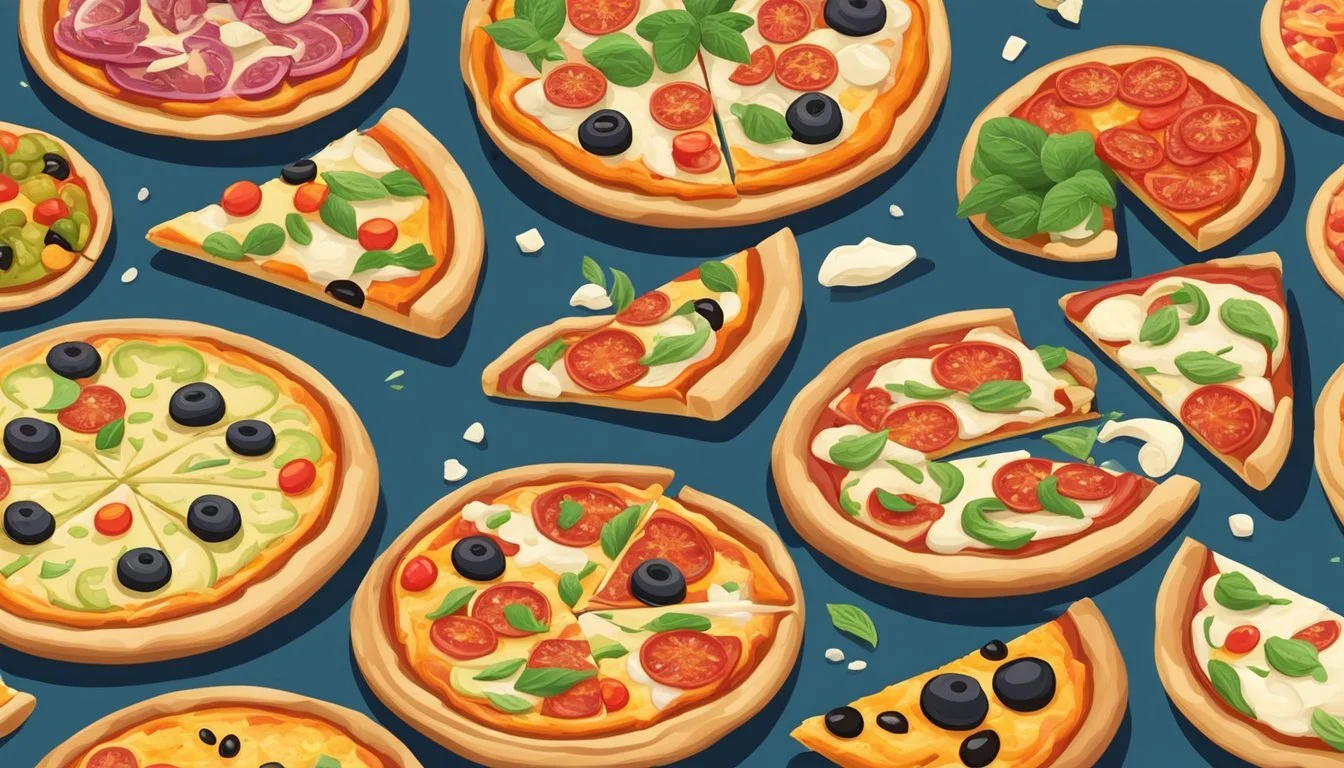Frozen vs Fresh Pizza: Convenience, Taste, and Value Compared
Pizza lovers often face a dilemma: frozen or fresh? While fresh pizza from a local pizzeria offers unmatched quality, frozen pizza provides a convenient alternative for quick meals at home. Modern frozen pizzas have improved significantly, with some brands rivaling the taste of restaurant-quality pies.
The best frozen pizzas combine high-quality ingredients, flavorful sauces, and crispy crusts to deliver a satisfying experience without the need for delivery or preparation. Popular options like cheese and pepperoni pizzas are widely available in the frozen aisle, offering classic flavors for easy enjoyment. Some gourmet frozen pizzas even feature premium toppings and artisanal crusts, elevating the at-home pizza experience.
While fresh pizza remains the gold standard for many, frozen pizzas have carved out their niche in the culinary world. They offer a balance of taste and convenience, making them a go-to choice for busy households and pizza enthusiasts alike. As frozen pizza technology continues to advance, the gap between frozen and fresh options narrows, giving consumers more delicious choices than ever before.
History and Evolution of Frozen Pizza
Frozen pizza emerged in the 1950s as part of the expanding frozen food industry. Its development was marked by technological advancements and changing consumer preferences.
The Rise of Frozen Foods
The frozen food industry gained momentum in the 1940s and 1950s. Increased refrigerator ownership and improved freezing techniques paved the way for frozen pizza's introduction.
In the early 1950s, frozen pizzas began appearing in grocery stores across the Northeastern United States. Joseph Bucci filed a patent application for frozen pizza in August 1950, marking an important milestone.
Regional producers dominated the market initially. Rose and Jim Totino started mass-producing frozen pizzas in 1962 from their plant in St. Louis Park, Minnesota. This move helped propel frozen pizza into the mainstream.
Innovations in Frozen Pizza
Manufacturers continually improved frozen pizza quality and variety. They developed new crust types, sauce formulations, and topping combinations to enhance taste and texture.
In the 1990s, rising-crust technology revolutionized the industry. DiGiorno introduced its "It's Not Delivery, It's DiGiorno" campaign, featuring pizzas that rose while baking.
Organic frozen pizzas entered the market, catering to health-conscious consumers. These products used organic ingredients and often featured whole grain crusts.
Frozen pizza makers also experimented with gluten-free options, veggie-based crusts, and premium toppings to appeal to diverse dietary needs and preferences.
Types of Frozen Pizza
Frozen pizzas come in a variety of styles to suit different tastes and dietary needs. From classic thin crust to hearty thick crust options, there's something for everyone in the freezer aisle.
Thin Crust Pizza
Thin crust frozen pizzas offer a crispy, light base for toppings. These pizzas cook quickly and provide a satisfying crunch with each bite. Many brands offer thin crust options, including traditional Italian-style and flatbread varieties.
Some thin crust pizzas feature a cracker-like texture, while others aim for a more authentic wood-fired taste. Popular toppings for thin crust pizzas include margherita, four cheese, and pepperoni.
Thick Crust Pizza
Thick crust frozen pizzas provide a heartier, more filling meal. These pizzas often have a soft, chewy interior and a crispy exterior. The thicker base allows for more generous toppings and sauce.
Many thick crust options mimic the style of pan pizzas found in pizzerias. Brands may offer stuffed crust varieties, adding an extra layer of cheese or other fillings inside the crust's edge.
Rising Crust Pizza
Rising crust pizzas aim to recreate the fresh-baked experience at home. These pizzas have a specially formulated crust that expands and rises during baking, resulting in a fluffy, bread-like texture.
The rising crust creates air pockets, giving the pizza a lighter feel compared to traditional frozen options. This style often comes with a variety of toppings, from classic cheese to supreme combinations.
Specialty Pizzas
Specialty frozen pizzas cater to various dietary preferences and restrictions. Gluten-free options use alternative flours like rice or corn to create a wheat-free crust. These pizzas allow those with gluten sensitivities to enjoy pizza without compromise.
Cauliflower crust pizzas have gained popularity as a low-carb alternative. These crusts use riced cauliflower as a base, often mixed with cheese and eggs to form a cohesive crust.
Vegan frozen pizzas exclude all animal products, using plant-based cheeses and meat alternatives. Some brands offer grain-free options, using nut flours or vegetable bases to create unique crusts.
Comparing Fresh and Frozen Pizza
Fresh and frozen pizzas offer distinct experiences in taste, texture, and nutrition. Both options have their place depending on convenience needs and personal preferences.
Taste and Texture Considerations
Fresh pizza generally delivers superior flavor and texture. The dough remains soft and chewy, with a crisp exterior when baked properly. Toppings retain their individual flavors and textures, creating a more vibrant taste profile.
Frozen pizzas often have a denser, crunchier crust due to the freezing process. The texture may be less varied, with toppings sometimes blending together. However, some high-quality frozen options can closely mimic fresh pizza's taste and texture.
Cheese on fresh pizzas melts more evenly and maintains a gooey consistency. Frozen pizza cheese may not spread as smoothly and can become slightly rubbery upon reheating.
Nutritional Differences
Fresh pizzas made with high-quality ingredients often contain fewer preservatives and additives. They can be customized to include healthier toppings and whole grain crusts, potentially increasing nutritional value.
Frozen pizzas frequently contain more sodium and preservatives to maintain shelf life. Some brands offer healthier options with whole grain crusts and vegetable toppings. Portion control may be easier with frozen pizzas due to their pre-portioned nature.
Fresh pizzas allow for better control over ingredient quality and quantity. This flexibility can lead to a more balanced nutritional profile when mindful choices are made.
Calorie content varies widely for both fresh and frozen pizzas, depending on toppings and crust types. It's essential to check labels or inquire about nutritional information when comparing options.
Major Brands and Offerings
The frozen pizza market offers a diverse range of options from established brands to innovative newcomers. Many companies cater to different tastes and dietary preferences, providing convenient meal solutions for consumers.
Prevalent Frozen Pizza Brands
DiGiorno leads the frozen pizza market with its rising crust pizzas. Red Baron follows closely, known for its classic thin crust options. California Pizza Kitchen brings restaurant-style pizzas to home freezers. Tombstone and Totino's offer budget-friendly choices popular among college students and families.
Newman's Own Thin & Crispy Crust Four Cheese Pizza stands out for its charitable contributions. Amy's caters to health-conscious consumers with organic ingredients. Whole Foods Market provides premium private-label frozen pizzas for discerning shoppers.
Up-and-Coming Brands
Caulipower has gained traction with its cauliflower-based crusts, appealing to low-carb dieters. Banza offers chickpea-crust pizzas high in protein and fiber. Screamin' Sicilian Pizza distinguishes itself with bold flavors and generous toppings.
These newer brands focus on alternative ingredients and unique flavor profiles. They often target health-conscious consumers or those with dietary restrictions. Their innovative approaches have carved out niches in the competitive frozen pizza market.
Ingredient Quality and Sourcing
High-quality ingredients are crucial for creating exceptional pizza, whether frozen or fresh. Careful sourcing and selection of premium components can significantly impact flavor, texture, and overall quality.
Organic and All-Natural Options
Many pizza makers now offer organic and all-natural options to meet consumer demand for cleaner ingredients. Organic flour, tomatoes, and vegetables are grown without synthetic pesticides or fertilizers. All-natural cheeses and meats contain no artificial preservatives or additives. These choices often result in fresher flavors and may appeal to health-conscious consumers.
Some brands use organic tomatoes for their sauce, which can provide a brighter, more authentic taste. Organic herbs and spices add depth without artificial flavorings. Pizza crusts made with organic wheat flour tend to have a nuttier flavor and better texture.
Meat and Dairy Ingredients
Quality meat and dairy ingredients play a vital role in pizza taste and texture. Uncured pepperoni, made without artificial nitrates or nitrites, offers a cleaner flavor profile. Some brands use antibiotic-free meats and dairy from grass-fed cows.
High-quality mozzarella, often fresh or minimally processed, melts better and provides superior stretch. Artisanal cheeses like Parmesan or Pecorino Romano can add complexity to flavor profiles. Ethically sourced meats from trusted suppliers ensure better taste and texture.
Many premium pizza makers prioritize hormone-free dairy products for improved flavor and ethical considerations. These choices often result in pizzas with richer tastes and more satisfying mouthfeel.
Cooking and Preparation
Proper cooking techniques are crucial for achieving the best results with frozen pizza. The method and temperature you choose can significantly impact the final texture and flavor.
Oven vs. Microwave Baking
Oven baking is the preferred method for cooking frozen pizza. Preheat the oven to 400-450°F for optimal results. Place the frozen pizza directly on the center rack to ensure even heating. Cooking time typically ranges from 15-25 minutes, depending on the pizza's size and thickness.
Microwaving is faster but often produces a softer crust. If using a microwave, place the pizza on a microwave-safe plate and cook on high for 3-4 minutes. Some frozen pizzas come with a special microwave crisping tray to help achieve a crispier crust.
For the best compromise between speed and quality, try a combination approach. Microwave the pizza for 2-3 minutes to thaw, then finish it in a preheated oven for 5-7 minutes to crisp the crust.
Tips for Achieving the Perfect Crisp
To get a crispier crust, preheat a pizza stone or baking sheet in the oven. This helps create a hot surface that immediately starts cooking the bottom of the pizza. Avoid thawing the pizza before baking, as this can lead to a soggy crust.
For extra crispiness, brush the crust with olive oil before baking. This helps create a golden-brown exterior. Adding a sprinkle of cornmeal to the baking surface can also enhance crispiness and prevent sticking.
If your pizza has a lot of toppings, consider par-baking the crust for a few minutes before adding them. This ensures the crust cooks through without burning the toppings.
Innovative Frozen Pizza Variations
Frozen pizza manufacturers are pushing boundaries with new flavors, ingredients, and dietary options. These innovations cater to evolving consumer preferences and dietary needs.
Culinary Trends in Frozen Pizza
Margherita pizza has become a popular choice for those seeking an authentic Italian experience at home. Many brands now offer versions with fresh mozzarella, basil, and San Marzano tomatoes.
BBQ chicken pizza has gained traction as a flavorful alternative to traditional toppings. These pizzas often feature tangy barbecue sauce, grilled chicken, red onions, and cilantro.
Some companies are experimenting with unique flavor profiles, incorporating ingredients like truffle oil, prosciutto, or even dessert-inspired toppings for adventurous consumers.
Dietary Accommodations in Pizza Offerings
Vegan frozen pizzas have seen significant growth, using plant-based cheeses and meat alternatives to cater to the increasing demand for animal-free options.
Gluten-free pizzas are now widely available, utilizing alternative flours like rice or chickpea to create crispy crusts suitable for those with celiac disease or gluten sensitivity.
Cauliflower crust pizzas have gained popularity as a low-carb option. Brands like Cappello's offer grain-free crusts made from almond flour and arrowroot flour.
Many manufacturers now focus on using organic, non-GMO ingredients to appeal to health-conscious consumers.
Consumer Reviews and Recommendations
Frozen pizza taste tests reveal popular picks that balance flavor, convenience, and affordability. Value-conscious consumers compare costs against quality to find satisfying options.
Popular Picks and Taste Tests
DiGiorno Rising Crust Pepperoni Pizza consistently ranks high in consumer taste tests. Its thick, fluffy crust and generous toppings appeal to many frozen pizza fans.
Screamin' Sicilian's Bessie's Revenge receives praise for its premium cheese blend and crispy crust. This option satisfies those seeking a more gourmet frozen pizza experience.
Amy's Margherita Pizza stands out for its simple, wholesome ingredients. Consumers appreciate its fresh-tasting tomato sauce and basil flavors.
Red Baron Brick Oven Crust Cheese Trio Pizza offers a crispy crust with a blend of mozzarella, cheddar, and parmesan cheeses. It's a popular choice for cheese lovers.
Finding Value: Cost vs. Quality
DiGiorno Original Rising Crust Four Cheese Pizza provides good value. Its substantial size and quality ingredients make it a cost-effective choice for families.
Budget-friendly options like Totino's and Jack's offer quick, affordable meals. While not gourmet, they satisfy basic pizza cravings at a low price point.
Mid-range brands such as California Pizza Kitchen and Newman's Own balance quality and affordability. These pizzas often feature unique flavor combinations and higher-quality ingredients.
Premium frozen pizzas command higher prices but deliver restaurant-quality taste. Brands like Roberta's and Table 87 cater to discerning palates willing to pay more for exceptional flavor.
Economic and Market Analysis
The frozen pizza market shows strong growth potential driven by convenience trends and changing consumer behaviors. Delivery services and innovative products are reshaping industry dynamics.
Sales Trends and Consumer Behavior
Frozen pizza sales in the U.S. reached $6.62 billion in 2022, with projections indicating a compound annual growth rate of 6.9% through 2030. This upward trajectory stems from busy lifestyles fueling demand for convenient meal options. Consumers increasingly stock freezers with ready-to-eat pizzas for quick meals.
The global frozen pizza market was valued at $19.6 billion in 2019, expected to grow at 3.2% annually through 2027. Millennials and working professionals are key drivers of this expansion. Premium frozen pizzas are gaining traction as consumers seek higher-quality options.
Impact of Delivery Services on Frozen Pizza Sales
Delivery services have reshaped the pizza landscape, influencing frozen pizza sales. While restaurant delivery grew, frozen pizza manufacturers adapted by improving quality and variety. Many brands now offer restaurant-style frozen pizzas to compete with delivery options.
Some companies partnered with delivery services to distribute frozen pizzas directly to consumers. This strategy expanded market reach and provided a convenient alternative to restaurant delivery. Test kitchens focused on developing frozen pizzas that maintain quality after reheating, aiming to match the fresh-delivered experience.
Packaging and Sustainability
Pizza packaging plays a crucial role in preserving freshness and reducing food waste. Manufacturers are increasingly adopting sustainable practices to minimize environmental impact while maintaining product quality.
Environmental Impact of Packaging
Traditional pizza packaging often relies on plastic and foam materials, contributing to landfill waste and pollution. Freezer-safe containers for frozen pizzas typically use multi-layer plastics that are difficult to recycle. These materials can take hundreds of years to decompose, posing long-term environmental challenges.
Some companies are exploring alternatives like biodegradable packaging made from cornstarch or sugarcane-based fibers. These materials break down more quickly and reduce the carbon footprint associated with production and disposal.
Initiatives in Eco-Friendly Production
Pizza manufacturers are implementing sustainable practices throughout their production processes. Many are focusing on reducing packaging waste and increasing recycled content in their materials.
Mercadona, for example, now uses recycled plastic in its frozen pizza packaging. This initiative helps decrease reliance on virgin plastics and promotes a circular economy approach.
Other companies are exploring innovative solutions like Koehler Paper's sealable paper technology. This advancement allows for plastic-free packaging that still maintains food safety and freshness standards.
Sonoco Products has developed a 100% sugarcane-based fiber bowl for frozen foods, offering a renewable alternative to traditional packaging options.
Convenient Meal Solutions
Pizza offers quick and easy mealtime options for busy households. From frozen varieties to ready-made crusts, there are numerous ways to enjoy pizza without extensive preparation.
Quick and Easy Pizza Options
Convenience stores and supermarkets stock a variety of ready-to-eat pizza options. Pre-made crusts allow for customization with favorite toppings. Some stores offer take-and-bake pizzas that simply need heating at home.
Frozen pizza bites make for simple snacks or appetizers. These bite-sized morsels come in various flavors and can be microwaved or oven-baked.
Many pizza chains now offer online ordering and delivery services, bringing hot, fresh pizzas directly to your door with minimal effort.
Frozen Pizza as a Mealtime Solution
Frozen pizzas have evolved significantly, offering improved quality and taste. Brands like Aldi's Mama Cozzi's provide affordable options without sacrificing flavor.
These pizzas require little preparation - simply preheat the oven and bake. Many come with a range of toppings, from classic cheese to gourmet combinations.
For a healthier twist, some frozen pizzas feature whole grain crusts or vegetable-based toppings. Pairing a frozen pizza with a side salad creates a more balanced meal.






